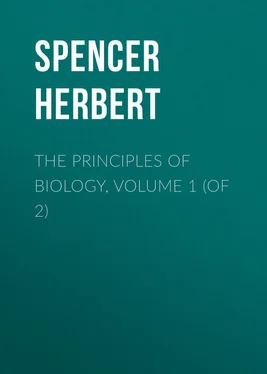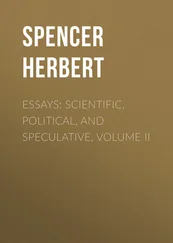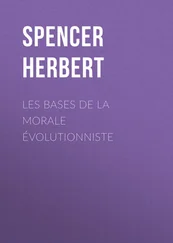Herbert Spencer - The Principles of Biology, Volume 1 (of 2)
Здесь есть возможность читать онлайн «Herbert Spencer - The Principles of Biology, Volume 1 (of 2)» — ознакомительный отрывок электронной книги совершенно бесплатно, а после прочтения отрывка купить полную версию. В некоторых случаях можно слушать аудио, скачать через торрент в формате fb2 и присутствует краткое содержание. Жанр: Философия, foreign_antique, foreign_prose, на английском языке. Описание произведения, (предисловие) а так же отзывы посетителей доступны на портале библиотеки ЛибКат.
- Название:The Principles of Biology, Volume 1 (of 2)
- Автор:
- Жанр:
- Год:неизвестен
- ISBN:нет данных
- Рейтинг книги:3 / 5. Голосов: 1
-
Избранное:Добавить в избранное
- Отзывы:
-
Ваша оценка:
- 60
- 1
- 2
- 3
- 4
- 5
The Principles of Biology, Volume 1 (of 2): краткое содержание, описание и аннотация
Предлагаем к чтению аннотацию, описание, краткое содержание или предисловие (зависит от того, что написал сам автор книги «The Principles of Biology, Volume 1 (of 2)»). Если вы не нашли необходимую информацию о книге — напишите в комментариях, мы постараемся отыскать её.
The Principles of Biology, Volume 1 (of 2) — читать онлайн ознакомительный отрывок
Ниже представлен текст книги, разбитый по страницам. Система сохранения места последней прочитанной страницы, позволяет с удобством читать онлайн бесплатно книгу «The Principles of Biology, Volume 1 (of 2)», без необходимости каждый раз заново искать на чём Вы остановились. Поставьте закладку, и сможете в любой момент перейти на страницу, на которой закончили чтение.
Интервал:
Закладка:
This, however, is no answer to the question – why has individual growth a limit? – why do the increments of growth bear decreasing ratios to the mass and finally come to an end? The question is involved. There are more causes than one why the excess of absorbed nutriment over expended nutriment must, other things equal, become less as the size of the animal becomes greater. In similarly-shaped bodies the masses, and therefore the weights, vary as the cubes of the dimensions; whereas the powers of bearing the stresses imposed by the weights vary as the squares of the dimensions. Suppose a creature which a year ago was one foot high, has now become two feet high, while it is unchanged in proportions and structure; what are the necessary concomitant changes? It is eight times as heavy; that is to say, it has to resist eight times the strain which gravitation puts upon certain of its parts; and when there occurs sudden arrest of motion or sudden genesis of motion, eight times the strain is put upon the muscles employed. Meanwhile the muscles and bones have severally increased their abilities to bear strains in proportion to the areas of their transverse sections, and hence have severally only four times the tenacity they had. This relative decrease in the power of bearing stress does not imply a relative decrease in the power of generating energy and moving the body; for in the case supposed the muscles have not only increased four times in their transverse sections but have become twice as long, and will therefore generate an amount of energy proportionate to their bulk. The implication is simply that each muscle has only half the power to withstand those shocks and strains which the creature's movements entail; and that consequently the creature must be either less able to bear these, or must have muscles and bones having relatively greater transverse dimensions: the result being that greater cost of nutrition is inevitably caused and therefore a correlative tendency to limit growth. This necessity will be seen still more clearly if we leave out the motor apparatus, and consider only the forces required and the means of supplying them. For since, in similar bodies, the areas vary as the squares of the dimensions, and the masses vary as the cubes; it follows that the absorbing surface has become four times as great, while the weight to be moved by the matter absorbed has become eight times as great. If then, a year ago, the absorbing surface could take up twice as much nutriment as was needed for expenditure, thus leaving one-half for growth, it is now able only just to meet expenditure, and can provide nothing for growth. However great the excess of assimilation over waste may be during the early life of an active organism, we see that because a series of numbers increasing as the cubes, overtakes a series increasing as the squares, even though starting from a much smaller number, there must be reached, if the organism lives long enough, a point at which the surplus assimilation is brought down to nothing – a point at which expenditure balances nutrition – a state of moving equilibrium. The only way in which the difficulty can be met is by gradual re-organization of the alimentary system; and, in the first place, this entails direct cost upon the organism, and, in the second place, indirect cost from the carrying of greater weight: both tending towards limitation. There are two other varying relations between degrees of growth and amounts of expended force; one of which conspires with the last, while the other conflicts with it. Consider, in the first place, the cost at which nutriment is distributed through the body and effete matters removed from it. Each increment of growth being added at the periphery of the organism, the force expended in the transfer of matter must increase in a rapid progression – a progression more rapid than that of the mass. But as the dynamic expense of distribution is small compared with the dynamic value of the materials distributed, this item in the calculation is unimportant. Now consider, in the second place, the changing proportion between production and loss of heat. In similar organisms the quantities of heat generated by similar actions going on throughout their substance, must increase as the masses, or as the cubes of the dimensions. Meanwhile, the surfaces from which loss of heat takes place, increase only as the squares of the dimensions. Though the loss of heat does not therefore increase only as the squares of the dimensions, it certainly increases at a smaller rate than the cubes. And to the extent that augmentation of mass results in a greater retention of heat, it effects an economization of force. This advantage is not, however, so important as at first appears. Organic heat is a concomitant of organic action, and is so abundantly produced during action that the loss of it is then usually of no consequence: indeed the loss is often not rapid enough to keep the supply from rising to an inconvenient excess. It is chiefly in respect of that maintenance of heat which is needful during quiescence, that large organisms have an advantage over small ones in this relatively diminished loss. Thus these two subsidiary relations between degrees of growth and amounts of expended force, being in antagonism, we may conclude that their differential result does not greatly modify the result of the chief relation.
Comparisons of these deductions with the facts appear in some cases to verify them and in other cases not to do so. Throughout the vegetal kingdom, there are no distinct limits to growth except those which death entails. Passing over a large proportion of plants which never exceed a comparatively small size, because they wholly or partially die down at the end of the year, and looking only at trees that annually send forth new shoots, even when their trunks are hollowed by decay; we may ask – How does growth happen here to be unlimited? The answer is, that plants are only accumulators: they are in no very appreciable degree expenders. As they do not undergo waste there is no reason why their growth should be arrested by the equilibration of assimilation and waste. Again, among animals there are sufficient reasons why the correspondence cannot be more than approximate. Besides the fact above noted, that there are other varying relations which complicate the chief one. We must bear in mind that the bodies compared are not truly similar: the proportions of trunk to limbs and trunk to head, vary considerably. The comparison is still more seriously vitiated by the inconstant ratio between the constituents of which the body is composed. In the flesh of adult mammalia, water forms from 68 to 71 per cent., organic substance from 24 to 28 per cent., and inorganic substance from 3 to 5 per cent.; whereas in the fœtal state, the water amounts to 87 per cent., and the solid organic constituents to only 11 per cent. Clearly this change from a state in which the force-evolving matter forms one-tenth of the whole, to a state in which it forms two and a half tenths, must greatly interfere with the parallelism between the actual and the theoretical progression. Yet another difficulty may come under notice. The crocodile is said to grow as long as it lives; and there appears reason to think that some predaceous fishes, such as the pike, do the same. That these animals of comparatively high organization have no definite limits of growth, is, however, an exceptional fact due to the exceptional non-fulfilment of those conditions which entail limitation. What kind of life does a crocodile lead? It is a cold-blooded, or almost cold-blooded, creature; that is, it expends very little for the maintenance of heat. It is habitually inert: not usually chasing prey but lying in wait for it; and undergoes considerable exertion only during its occasional brief contests with prey. Such other exertion as is, at intervals, needful for moving from place to place, is rendered small by the small difference between the animal's specific gravity and that of water. Thus the crocodile expends in muscular action an amount of force that is insignificant compared with the force commonly expended by land-animals. Hence its habitual assimilation is diminished much less than usual by habitual waste; and beginning with an excessive disproportion between the two, it is quite possible for the one never quite to lose its advance over the other while life continues. On looking closer into such cases as this and that of the pike, which is similarly cold-blooded, similarly lies in wait, and is similarly able to obtain larger and larger kinds of prey as it increases in size; we discover a further reason for this absence of a definite limit. To overcome gravitative force the creature has not to expend a muscular power that is large at the outset, and increases as the cubes of its dimensions: its dense medium supports it. The exceptional continuance of growth observed in creatures so circumstanced, is therefore perfectly explicable.
Читать дальшеИнтервал:
Закладка:
Похожие книги на «The Principles of Biology, Volume 1 (of 2)»
Представляем Вашему вниманию похожие книги на «The Principles of Biology, Volume 1 (of 2)» списком для выбора. Мы отобрали схожую по названию и смыслу литературу в надежде предоставить читателям больше вариантов отыскать новые, интересные, ещё непрочитанные произведения.
Обсуждение, отзывы о книге «The Principles of Biology, Volume 1 (of 2)» и просто собственные мнения читателей. Оставьте ваши комментарии, напишите, что Вы думаете о произведении, его смысле или главных героях. Укажите что конкретно понравилось, а что нет, и почему Вы так считаете.












